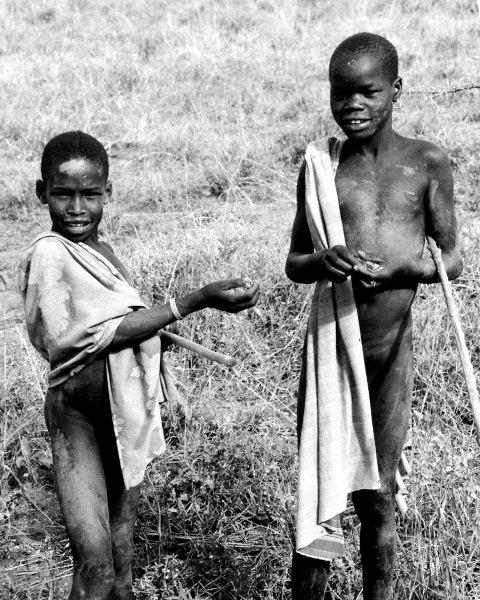
African Tribes: The Karamojong

Figure 1.-- The Karamojong sometimes written as Karimojong are an ethnic groups comprising several different related tribes known as a cluster. They inhabit primarily northeast Uganda near the South Sudan and Kenya borders. They are traditional agro-pastoral herders who in outward appearance resemble the related and better known Maasai pastoralists. Like the Masai, have a cattle culture. The area of northeast Uganda where they live is an isolated area. Thy have had less contact with Westerners than most other Ugandan tribes. Many Karamojong still do not wear western-style clothes. They tend to wear traditional dress consisting of a blanket worn like a shawl, often choosing red and black. Several tribes from Uganda, South Sudan, and Ethiopian (Omo Valley) are very traditiional. The boys seeve as sheperds from an aearly age, commonly wearing little except for a blanket to keep warm. Anthropologists see this as an element of paleo-African culture.
|
|
The Karamojong sometimes written as Karimojong are an ethnic groups comprising several different related tribes known as a cluster. They inhabit primarily northeast Uganda near the South Sudan and Kenya borders. They are centered in the southern part of the Ugandan Karamoja region, about 10 percent of the area of modern Uganda. They speak Karamojong which is one of the lanuages of the Nilo-Saharan language group. Anthropologists based largely on lingistics believe that the Karamojong as part of a sinle grouping migrated from Ethiopia (17th century). The reason for the migration is unknown, but may have been caused by drought. As they neared what is now Kenya, the migrants split, fragmenting into smaller groups. One branched settled im what is modern Kenya and developed into the Kalenjin group and Maasai tribal cluster. The other branch, the Ateker, migrated further west. The Ateker split into several additional groups, including the Turkana in western Kenya. Several tribal groups developed in Uganda, including the Iteso, Dodoth, Jie, Karamojong, and Kumam. The related Jiye and Toposa settled in what is now South Sudan. All of these tribes make up the Teso or Karamojong Cluster. They are traditional agro-pastoral herders who in outward appearance resemble the related and better known Maasai pastoralists. Like the Masai, have a cattle culture. They are constantly moving their herd around a difficult teraine searching for grazing land. They have in Uganda developed an usavary reputation as cattle raiders. The area of northeast Uganda where they live is an isolated area. Thy have had less contact with Westerners than most other Ugandan tribes. Many Karamojong still do not wear western-style clothes. They tend to wear traditional dress consisting of a blanket worn like a shawl, often choosing red and black. The women produce elaborate beadwork for decoration.
HBC

Navigate the Boys' Historical Clothing Web Site:
[Introduction]
[Activities]
[Biographies]
[Chronology]
[Cloth and textiles]
[Clothing styles]
[Countries]
[Topics]
[Bibliographies]
[Contributions]
[FAQs]
[Glossaries]
[Images]
[Links]
[Registration]
[Tools]
[Boys' Clothing Home]
Navigate the Boys' Historical Clothing national pages:
[Return to the Main Ugandan page]
[Return to the Main African tribal page]
[Burundi]
[Central African Republic]
[Congo]
[Eritea]
[Ethiopia]
[Kenya]
[Madagascar]
[Somalia]
[South Sudan]
[Sudan]
[Tanzanai]
[Uganda]
Created: 10:46 PM 1/1/2014
Last updated: 9:59 PM 8/28/2018



